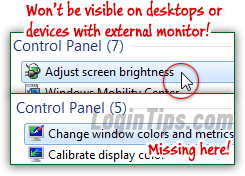

The ACPI override is intended to be used in conjunction with the brightness target override, and only when the display driver does not already provide brightness support. The ACPI override (the second bit) is valid on both internal and external displays but must only be applied to exactly one display on the system. The ACPI brightness override is not the preferred mechanism to use for brightness control, but is included for completeness, in situations where there is no other option for brightness control. If a system does have an internal display on an internal connector type, then the first enumerated display will receive the brightness control. The brightness support control override (the first bit) should only be used on a system which does not have an internal display on an internal connector type on any display adapter. OEMs should only define the “BrightnessControl” registry value when it is required. OEMs that would like to enable brightness control on a non-internal panel must ship their own monitor.inf (see sample inf below) and set this registry value appropriately. The remaining 30bits are reserved and must be zero.The second bit defines an ACPI override that forces ACPI brightness to be used.The first bit in this registry value defines the non-internal monitor brightness control support.

Where XXXX is for the targeted individual display. Registry Path: HKLM\SYSTEM\CurrentControlSet\Control\Class\XXXX General requirementsĪ new DWORD registry value will be added: “BrightnessControl”. This feature also does not support the ability to control the individual panel brightness on multiple display panels. This feature only allows OEMs to indicate to Windows that an external connector display supports brightness control OEMs must still implement the hardware brightness control and integrate that with the graphics driver as they would for an integrated connector display. For those configurations, Windows has the ability to designate exactly one display panel to support the system software brightness control. Some OEM systems have internal displays that are connected using external connectors such as HDMI.


 0 kommentar(er)
0 kommentar(er)
